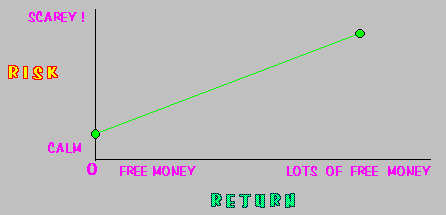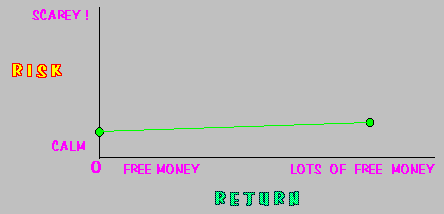The objective of an investor is to obtain the largest possible
rate of return without placing invested funds at more risk than is bearable.
Your reluctance to assume risk limits your ability to maximize returns.
Investors should not assume the risk of greater loss than they can
afford. The basic idea --
maximize return and minimize risk.
Probability and the Holding Period
Return = Money You Get
The rate of return is the most important outcome from any investment.
Both the gain in an assets value over time (the capital gain) and the
monies received while holding an asset (the cash dividend) are of interest
to any investor. If you add the cash you receive in hand
(like interest payments and dividends) together with any
capital gain and divide it by the purchase price, you when then know the
true return on your money.
Capital Gain (or loss) + Cash Dividend / Purchase Price =
THE RETURN ON YOUR INVESTMENT
Probability = The Chance That You Get The Money
A probability is a number that describes the likelihood of "something."
Probabilities can vary from 0 to 100 percent. An investor who
examines the probability of receiving a return will see
that there are many investments with 0 (or close to 0) percent
risk and significant rates of return -- like U.S. Treasury Bills.
Risk
So, how willing are you to lose? Assets having a greater
probability of loss are felt as more risky than those with lesser chance of
loss. The trick is getting the greatest rate of return with the least
amount of risk.
A common approach to evaluating the risk of an asset involves estimating
the pessimistic (worst),
the most likely (expected), and the optimistic (best) return associated with a given
asset. If you take a group of investments and plot the estimated risk
against the return, it usually looks like this --

Diversification
In order to reduce overall risk (the steepness of the above graph)
it is best to acquire, or add to the
existing portfolio, assets that are not related. The technical term for this
is not putting all your eggs in one basket. That way if you trip, you won't break all the
eggs. Now let's translate that over to your money:
The creation of a portfolio by combining two assets that behave exactly the same
way cannot reduce the portfolio's overall risk below the risk of the least risky
asset. (Here comes the important part)The creation of
a portfolio by combining two or more
assets that behave exactly opposite can reduce
the portfolio's total risk to a level below that of either asset alone --
which in certain situations may be zero.
Your well diversified portfolio will look more like this:

How to Best Diversify Your Portfolio
Have your funds invested in more than one asset (or more than one type of
asset.) For instance, if your company gives you stock as a bonus or part of
your benefits, you should consider investing some of it in other unrelated
assets. What if your industry takes a beating, you lose your job, and
the value of your "savings" is cut in two? Another example is leaving cash
in a bank account (or equity in your house.) Though the risk is low, so is the rate of
return. By
spreading the funds to other assets, the increase in risk will only be
slight, whereas the increase in rate of return will be great.
Here are three easy ways to do it:
Invest in individual stocks and bonds
Invest in
options
Invest the equity of your home more wisely


